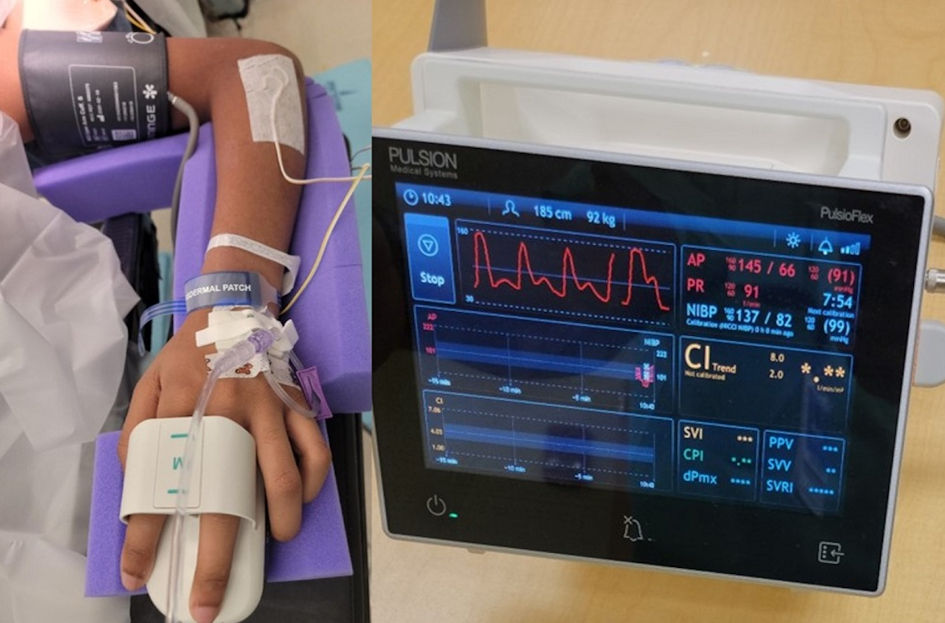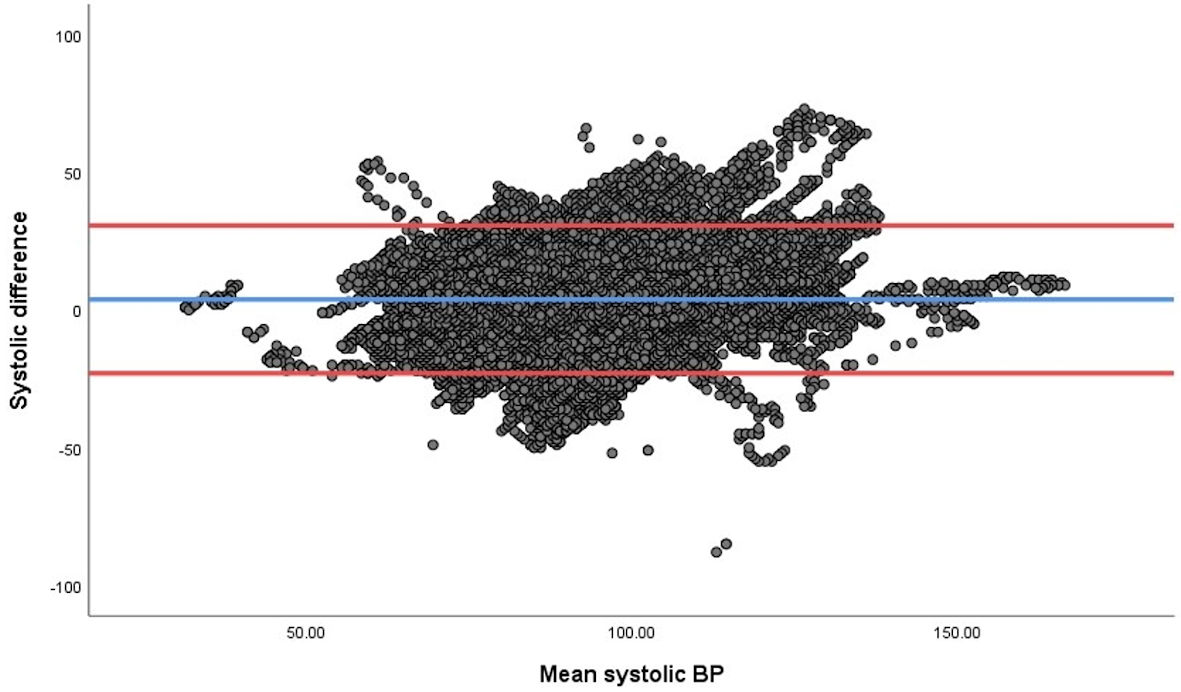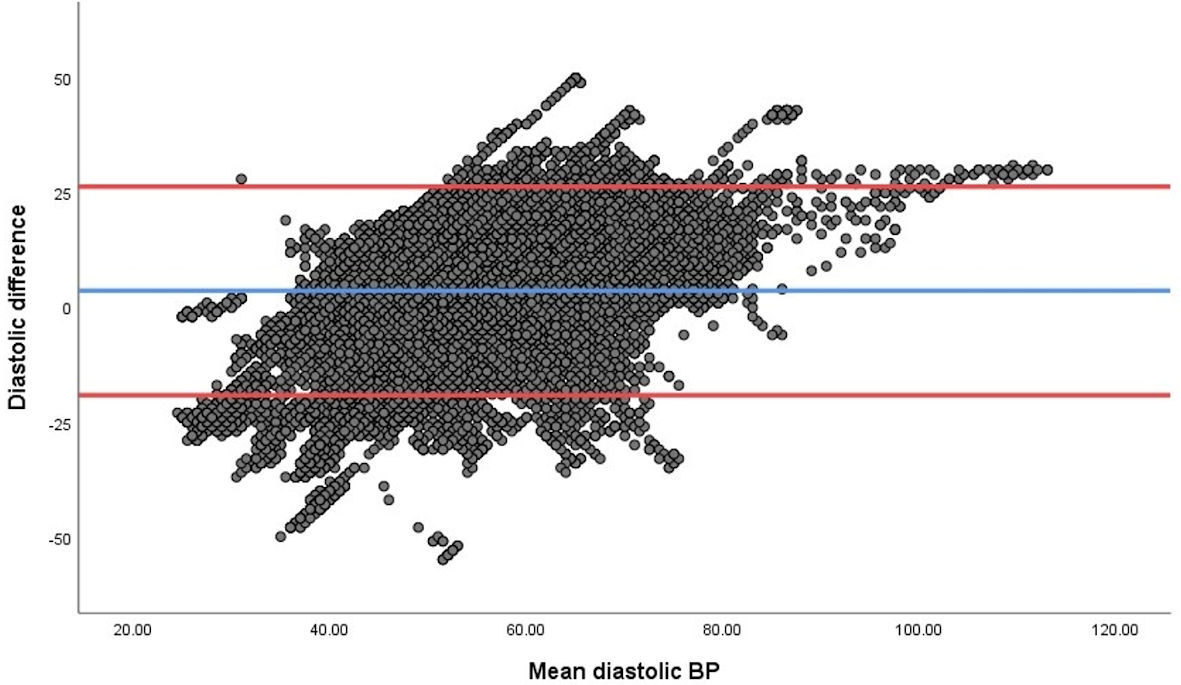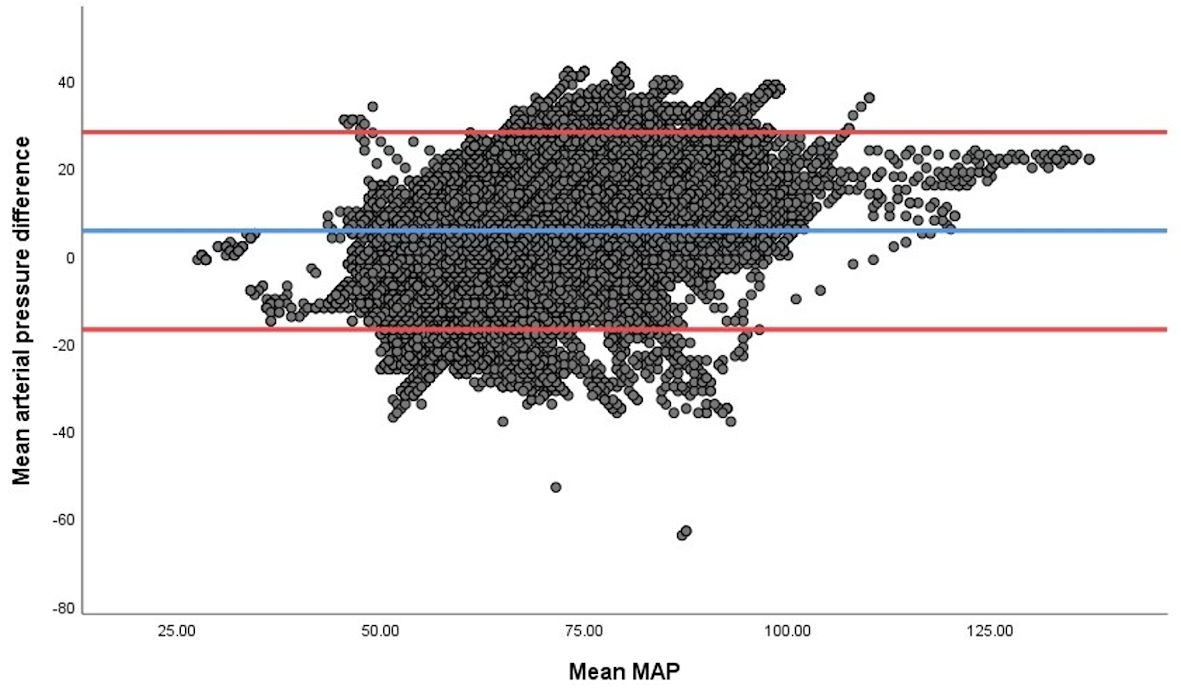Figures

Figure 1. The NICCI device attached to a patient in the prone position with the calibrating noninvasive blood pressure cuff and finger cuffs in place (left). The inflation of the two finger cuffs is alternated to avoid pressure injury. The external pressure required to maintain blood flow within the fingers is measured using infrared technology. The pressure is then converted into a continuous readout which is displayed on the bedside monitor (right).

Figure 2. Bland-Altman analysis of the agreement for systolic blood pressure (SBP) readings from the arterial cannula (AC) and the NICCI monitor (NM). The difference between the NM and AC values are plotted on the vertical axis while the average of the two values is plotted on the horizontal access. All values are in mm Hg. The red horizontal lines demonstrate the 95% limits of agreement, and the blue horizontal line corresponds to the bias.

Figure 3. Bland-Altman analysis of the agreement for diastolic blood pressure (DBP) readings from the arterial cannula (AC) and the NICCI monitor (NM). The difference between the NM and AC values are plotted on the vertical axis while the average of the two values is plotted on the horizontal access. All values are in mm Hg. The red horizontal lines demonstrate the 95% limits of agreement, and the blue horizontal line corresponds to the bias.

Figure 4. Bland-Altman analysis of the agreement for mean arterial pressure (MAP) readings from the arterial cannula (AC) and the NICCI monitor (NM). The difference between the NM and AC values are plotted on the vertical axis while the average of the two values is plotted on the horizontal access. All values are in mm Hg. The red horizontal lines demonstrate the 95% limits of agreement, and the blue horizontal line corresponds to the bias.
Tables
Table 1. Demographic and Clinical Characteristics of Study Cohort
| 10 - 40 kg | 10 - 25 kg | 25 - 40 kg |
|---|
| Data are presented as n (%), mean ± SD. BMI: body mass index; ASA: American Society of Anesthesiology; SD: standard deviation. |
| Gender, n (%) | | | |
| Female | 12 (50) | 3 (43) | 9 (53) |
| Male | 12(50) | 4 (57) | 8 (47) |
| Age (years) | 11 ± 4 | 6 ± 2 | 13 ± 3 |
| Weight (kg) | 30 ± 8 | 20 ± 4 | 34 ± 4 |
| Height (cm) | 134 ± 19 | 112 ± 13 | 142 ± 14 |
| BMI (kg/m2) | 17 ± 2 | 16 ± 2 | 17 ± 2 |
| Type of procedure (n) | | | |
| Orthopedic | 17 | 3 | 14 |
| Cardiothoracic | 4 | 2 | 2 |
| Neurosurgical | 3 | 2 | 1 |
| Patient position (n) | | | |
| Prone | 18 | 4 | 14 |
| Supine | 6 | 3 | 3 |
| ASA physical class (n) | | | |
| I | 1 | 0 | 1 |
| II | 10 | 3 | 7 |
| III | 10 | 3 | 7 |
| IV | 3 | 1 | 2 |
Table 2. Comparison of Blood Pressure Readings From the Arterial Cannula and the NM Monitor
| Parameter | Arterial cannula vs. NM | Percentage of NM readings ≤ 5 mm Hg from AC | Percentage of NM readings ≤ 10 mm Hg from AC | Percentage of NM readings > 10 mm Hg from AC | Correlation coefficient |
|---|
| Data are displayed in mm Hg as the mean ± SD of absolute values or as percentages. Values are compared to those obtained from the arterial cannula. BP: blood pressure; MAP: mean arterial pressure; NM: NICCI monitor; AC: arterial cannula; SD: standard deviation. *Correlation is significant with a P value ≤ 0.01 (two-tailed). |
| Systolic BP | 11 ± 9 | 32% | 57% | 43% | 0.65* |
| Diastolic BP | 10 ± 7 | 35% | 60% | 40% | 0.43* |
| MAP | 10 ± 7 | 31% | 56% | 44% | 0.59* |
Table 3. Bland-Altman Analysis Comparing Blood Pressure Readings From the Arterial Cannula and NM Monitor
| Parameter | Bias | Precision | 95% level of agreement |
|---|
| Data are presented in mm Hg rounded to the nearest whole integer. Values are compared to those obtained from an arterial cannula. BP: blood pressure; MAP: mean arterial pressure; NM: NICCI monitor. |
| Systolic BP | 4 | 14 | -23 to +31 |
| Diastolic BP | 4 | 12 | -19 to +26 |
| MAP | 6 | 12 | -17 to +28 |
Table 4. Comparison of Blood Pressure Readings From the Arterial Cannula and NM Monitor Based on Weight
| Parameter | Arterial cannula vs. NM | Percentage of NM readings ≤ 5 mm Hg from AC | Percentage of NM readings ≤ 10 mm Hg from AC | Percentage of NM readings > 10 mm Hg from AC | Correlation coefficient |
|---|
| Data are displayed in mm Hg as the mean ± SD of absolute values or as percentages. Values are compared to those obtained from the arterial cannula. BP: blood pressure; MAP: mean arterial pressure; NM: NICCI monitor; AC: arterial cannula; SD: standard deviation. *Correlation is significant with a P value ≤ 0.01 (two-tailed). |
| 10 - 25 kg | | | | | |
| Systolic BP | 10 ± 8 | 36 | 59 | 40 | 0.70* |
| Diastolic BP | 9 ± 7 | 40 | 66 | 34 | 0.83* |
| MAP | 10 ± 7 | 27 | 56 | 44 | 0.77* |
| 25 - 40 kg | | | | | |
| Systolic BP | 11 ± 9 | 31 | 56 | 44 | 0.73* |
| Diastolic BP | 10 ± 7 | 34 | 59 | 41 | 0.69* |
| MAP | 11 ± 8 | 31 | 56 | 44 | 0.66* |
Table 5. Bland-Altman Analysis Based on Weight
| Parameter | Bias | Precision | 95% level of agreement |
|---|
| Data are presented in mm Hg rounded to the nearest whole integer. Values are compared to those obtained from an arterial cannula. BP: blood pressure; MAP: mean arterial pressure. |
| 10 - 25 kg | | | |
| Systolic BP | 7 | 11 | -15 to +29 |
| Diastolic BP | 6 | 10 | -13 to +25 |
| MAP | 9 | 8 | -8 to +26 |
| 25 - 40 kg | | | |
| Systolic BP | 3 | 14 | -24 to + 31 |
| Diastolic BP | 4 | 12 | -20 to + 27 |
| MAP | 5 | 12 | -19 to + 28 |



